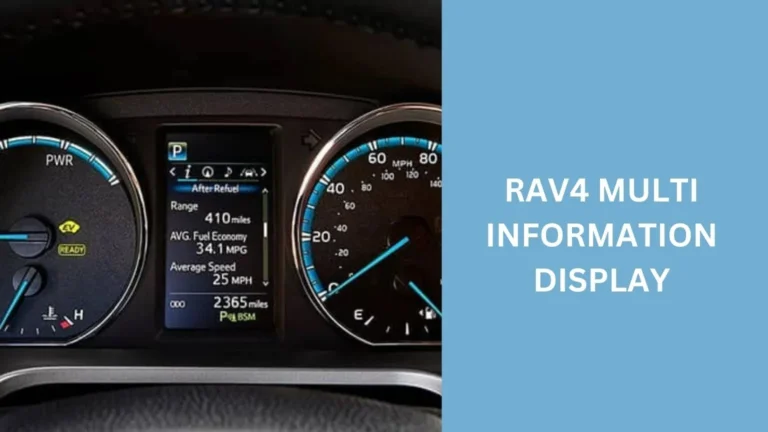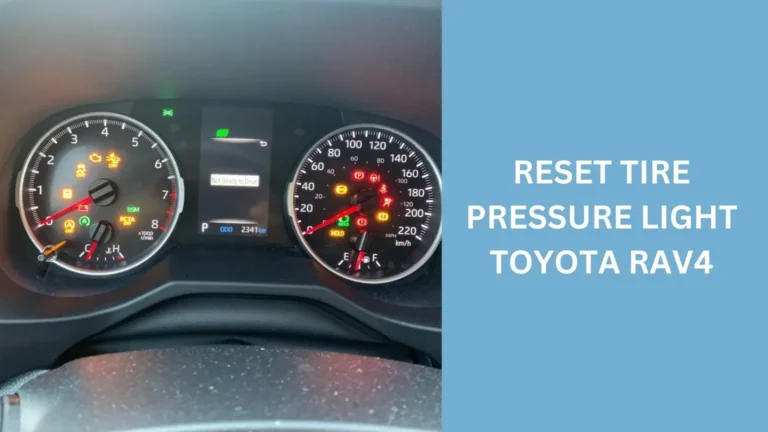Traction Control Toyota RAV4: Common Issues & Fix
Traction control is a critical safety feature in modern vehicles, including the Toyota RAV4. It helps to ensure that your car maintains optimal traction on the road, especially in slippery or off-road conditions.
Traction Control Toyota RAV4, In this article, we’ll take a deep dive into what traction control is, how it works in the Toyota RAV4, and common issues you may face with this feature.

What is Traction Control?
Traction control is a system designed to prevent wheel slip when you accelerate. It’s particularly helpful when driving on surfaces where there is a lack of grip, such as wet roads, snow, or gravel.
The traction control system (TCS) works in tandem with the Anti-lock Braking System (ABS) to ensure stability while driving.
How Does Traction Control Work in Toyota RAV4?
In the Toyota RAV4, the traction control system monitors the rotation of each wheel. If the system detects that one or more wheels are spinning faster than others, indicating a loss of traction, it automatically reduces engine power or applies brakes to the slipping wheels to regain control.
Why is Traction Control Toyota RAV4 Important?
Traction control is important because it significantly enhances vehicle safety and performance, especially in challenging driving conditions. Here’s why it matters:
Safety in Slippery Conditions
One of the main reasons traction control is essential is that it enhances safety in slippery or unpredictable driving conditions.
Whether you’re driving in the rain, on ice, or through mud, traction control helps keep your vehicle stable and reduces the risk of sliding or skidding.
Improved Off-Road Capability
The Toyota RAV4 is often praised for its off-road performance, and the traction control system plays a significant role here.
When driving off-road, especially on loose terrain like sand or dirt, the system ensures that power is distributed evenly across all wheels, preventing any wheel from losing grip.
How to Use Traction Control in Toyota RAV4
Using traction control in your Toyota RAV4 is straightforward and essential for ensuring safe driving, especially in challenging conditions.
Here’s a step-by-step guide on how to use and manage the traction control system:
Turning Traction Control On and Off
In most Toyota RAV4 models, traction control is automatically enabled when you start the vehicle.
However, there may be instances where you want to turn off the system, such as when you’re stuck in snow or mud and need your wheels to spin freely to get out.
To turn off traction control in a Toyota RAV4, locate the TRAC OFF button on the dashboard. Press and hold the button for a few seconds until the “TRAC OFF” light illuminates on the instrument panel. To re-enable the system, press the button again.
When Should You Turn Traction Control Off?
While traction control is generally beneficial, there are certain situations where turning it off can be helpful:
- Stuck in deep snow or mud: If you’re trying to get your RAV4 out of deep snow or mud, turning off traction control can allow the wheels to spin freely, increasing your chances of getting unstuck.
- Off-roading: In some off-road scenarios, turning off traction control can improve your vehicle’s performance by allowing the wheels to spin more, especially when dealing with loose surfaces.
Common Traction Control Issues in Toyota RAV4
While the traction control system in the Toyota RAV4 is reliable, like any other system, it can sometimes malfunction. Here are a few common issues drivers may encounter.
1. Traction Control Warning Light Stays On
If the traction control warning light stays on, it could indicate a problem with the system. This could be due to a malfunctioning sensor, low brake fluid levels, or even a problem with the ABS.
If this light comes on and stays on, it’s important to have your vehicle checked by a mechanic as soon as possible.
2. Traction Control Not Activating
In some cases, drivers have reported that the traction control system doesn’t activate when it should.
This can be particularly dangerous in slippery conditions. If you notice that your traction control isn’t working, it could be due to a faulty sensor or the system may need recalibration.
3. Traction Control Engaging Too Frequently
On the opposite end of the spectrum, you may find that the traction control system engages too often, even in normal driving conditions.
This could be caused by overly sensitive sensors or problems with your tires. Ensuring that your tires are properly inflated and in good condition can help mitigate this issue.
How to Fix Traction Control Issues in Toyota RAV4
If you’re experiencing problems with your RAV4’s traction control system, here are a few steps you can take to resolve the issue.
1. Check for Error Codes
Most modern vehicles, including the Toyota RAV4, are equipped with an onboard diagnostics system (OBD-II).
If there’s an issue with the traction control, the system will likely store an error code. Using an OBD-II scanner, you can check for any codes related to traction control and use them to pinpoint the problem.
2. Inspect Wheel Sensors
Since the traction control system relies on data from the wheel sensors, any dirt or damage to these sensors can cause issues. Cleaning or replacing the sensors may resolve the problem.
3. Check Brake Fluid Levels
Low brake fluid can trigger the traction control warning light. Make sure your brake fluid is at the recommended level and refill if necessary.
4. Visit a Mechanic
If you’re unable to diagnose or fix the issue on your own, it’s always a good idea to visit a qualified mechanic. They can run a thorough inspection and ensure that the traction control system is functioning correctly.
People also ask
What is traction control in a Toyota RAV4?
Traction control in a Toyota RAV4 is a safety feature designed to prevent wheel spin and maintain traction on slippery surfaces.
It works by monitoring the rotation of each wheel and adjusting engine power or applying brakes to the wheels that are slipping.
This helps enhance stability and control, especially in challenging driving conditions such as rain, snow, or off-road terrain.
Essentially, it ensures that the vehicle remains stable and safe while driving, preventing skidding or loss of control.
Should you have traction control on or off?
You should generally keep traction control on while driving, as it enhances safety by preventing wheel spin and maintaining vehicle stability, especially in slippery conditions.
However, you might consider turning it off in specific situations, like when you’re stuck in deep snow or mud, as this allows the wheels to spin more freely to help you get unstuck.
Always remember to turn it back on once you’re back on stable ground.
How do you turn off traction control on a Toyota rav4 hybrid?
To turn off traction control on a Toyota RAV4 Hybrid, follow these steps:
Locate the TRAC OFF Button: Find the TRAC OFF button on the dashboard, usually near the steering wheel.
Press the Button: Press and hold the button until the TRAC OFF light appears on the instrument panel, indicating that traction control is disabled.
Conclusion
Traction Control Toyota RAV4 is an essential feature that enhances both safety and performance.
Whether you’re navigating icy roads or tackling rough off-road terrain, the system helps maintain stability and control.
Understanding how it works and knowing how to troubleshoot common issues will ensure that you get the most out of your Toyota RAV4’s traction control system.
I’m Micle R, and I’m thrilled to share my passion for the Toyota RAV4 with you. This site is dedicated to everything you need to know about this incredible vehicle, from detailed reviews and maintenance tips to the latest news and updates.





